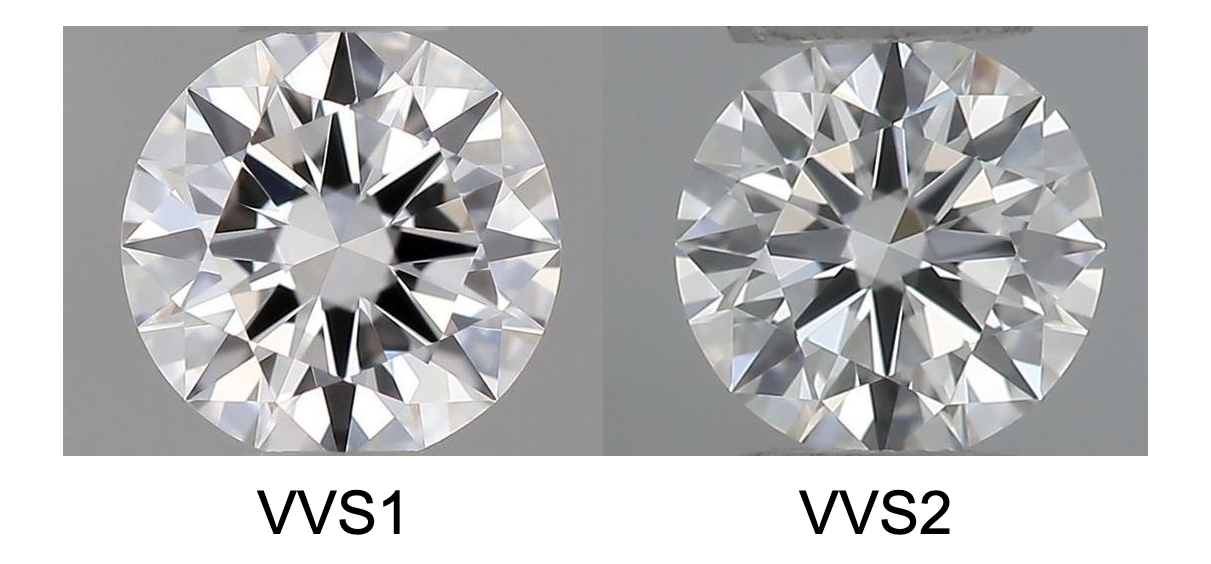Anatomy of a Diamond

When assessing a diamond’s quality, the 4 Cs provide a very reliable overview. Yet a gemologist or experienced diamond buyer looks beyond the 4 Cs at even more subtle details. These details include the diamond’s structure and its angles, its level of fluorescence, the degree of inclusions, and the quality of its polish. Read on to learn about each of these topics.
Diamond Structure
While diamonds come in many shapes and sizes, there are five structural elements that all diamonds share. The angles that these five elements create determine how much light the diamond is able to reflect — and thus how brilliant it is.

Table - The table is the flat, topmost surface of a diamond. It is the largest facet, regardless of the diamond's shape.
How It Works: A diamond's table refracts light rays downward as they enter the diamond. In turn, that light is reflected back up from the pavilion and through the table — thus, most of a diamond’s light reaches an observer’s eye through the table. The size of the table impacts the amount of light that can enter the diamond. It is, therefore, an important factor gemologists use when assigning a diamond a cut grade.
Crown - A diamond's crown encompasses everything that sits above the girdle.
How It Works: Similar to the diamond table, refracted light passes down through the crown, and is then reflected back up from the pavilion into the observer's eyes. The various facets disperse light in different directions, resulting in a colorful, stunning fire.
Girdle - The girdle is the widest part of a diamond: the outermost edge where the crown and pavilion connect. When placed in a halo or bezel engagement ring setting, the girdle is typically hidden and level with the metal as it meets the diamond. In a prong or channel set engagement ring, the girdle can be seen where no metal touches the diamond.
How It Works: Gemologists consider a diamond's girdle width when assigning a cut grade. If the girdle is too thin or too thick, they will only assign a Very Good or Good cut grade to diamonds even if they have plenty of sparkle and structural stability.
Pavilion - A diamond's pavilion is the area beginning at the girdle and ending at the culet.
How It Works: The bulk of a diamond's weight is typically held in its pavilion. This means it is often considered the most valuable part of the diamond — and yet its angles are more important than its size.
It is critical for a diamond's pavilion to be neither too deep or nor shallow. An overly deep pavilion brings a darkened effect to the diamond, since it does not reflect enough light back up to the observer's eye through the crown. A shallow pavilion creates a 'fish-eye' effect if viewed from the table, caused by the girdle reflecting in the middle of the table, appearing dull and lacking in scintillation.
The optimal pavilion angle is between 42.5% and 43.5%.
Culet - The culet (pronounced cue-let) is the very bottom of a diamond's pavilion. It is either a point or a tiny facet that lies parallel with the table (i.e. the top of the diamond). If a facet, it can be polished or left unpolished.
How It Works: If a culet is larger than average, it may affect the overall appearance of the diamond: When looking down through the table at the diamond – as when set in an engagement ring – a large culet may be visible. A large culet allows a greater amount of light to escape through the bottom of the diamond, rather than reflecting it back to the observer's eyes, resulting in a noticeable dark circle.
Diamonds with small culets are likely to exhibit the most brilliance.
Diamond Proportions
When a gemologist grades a diamond, she measures its proportions and then calculates five ratios: depth percentage, table percentage, crown angle and pavilion angle. These ratios help to determine the diamond’s cut grade, and are included on its grading report.
Depth Percentage

The depth percentage is one of the key factors in determining a diamond’s grade of cut. Depth percentage is expressed as a ratio of the distance between the table to the culet and the diameter of the diamond measured across the girdle.
Depth should measure 54% to 66% of the diamond’s diameter in order to optimize sparkle. Diamonds with a cut grade of Very Good and Ideal have a depth percentage within this range.
Table Percentage

Table percentage is all about balancing the width of the table and the diameter of the diamond to produce optimal sparkle. If the width of the table is too large or small compared to the diameter of the diamond, the top of the diamond will appear flat or rounded, and either way sparkle is compromised.
The ideal table percentage falls within the range of 53% to 70%.
Crown Angle

If the crown angle is too large, sparkle will be limited when viewed from above. If the crown angle is too small, the top of the diamond could appear clear and glassy. Diamonds cut with an optimal angle will yield more sparkle.
Most round diamonds have a crown angle between 30% and 35%. The crown angle for a round Ideal cut diamond must be between 33.7% and 35.8%.
Pavilion Angle
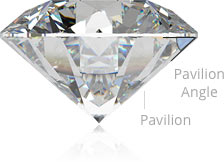
As with the crown angle, if the pavilion angle is too large, it will not emit notable sparkle. If it is too shallow, the diamond could appear glassy. When cut for brilliance, the pavilion will reflect the most sparkle to your eye through the top of the diamond.
The optimal pavilion angle is within the range of 42.5% to 43.5%.
These three diamonds illustrate the difference between a diamond with the correct proportions (center) and diamonds that are too shallow (left) or too deep (right).
 |  | 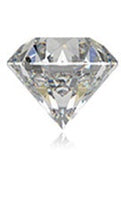 |
| Depth percentage too shallow: 53% and below. Table percentage too low. Crown and pavilion angles too shallow. | Depth percentage is ideal for maximum sparkle: 54-66%. Table percentage is ideal. Crown and pavilion angles are optimal. | Depth percentage too deep: 67% and above. Table percentage too high. Crown and pavilion angles too large. |
Note: the percentages above are specific to a round shaped diamond. The ideal proportions for other diamond shapes are all slightly different.
Diamond Symmetry
When grading a diamond, a gemologist evaluates the symmetry of its facets. Symmetry is an important factor in a diamond’s cut grade, and this is reflected in diamond pricing: A diamond with Excellent symmetry and polish may cost 10 to 15% more than a diamond with Good symmetry and polish.
Why is symmetry important? When all the facets of a diamond are perfectly aligned, the light entering it is reflected back, creating brilliance. When the facets do not align well, less light is reflected, creating shadowed spots.
Diamond symmetry is graded on a scale from Excellent to Poor. Excellent symmetry indicates perfect alignment of all facets. A diamond's symmetry can be compromised if the culet and table are off-center, if the facets are misshapen, or if the girdle is not straight. A misalignment of the crown and girdle is also a symmetry flaw.
The symmetry grade of a certified diamond is shown on its grading report. Ritani does not offer diamonds with Fair or Poor symmetry grades, so you can be sure of your diamond's superior brilliance.
Diamond Inclusions and Blemishes
A diamond's clarity grade is based on how big and how visible its inclusions and blemishes are. An inclusion is a natural flaw within a diamond, and a blemish is a naturally caused imperfection on the stone's surface. Distinct from polish defects, blemishes occur naturally and are not due to human errors during the polishing process.
Cavity
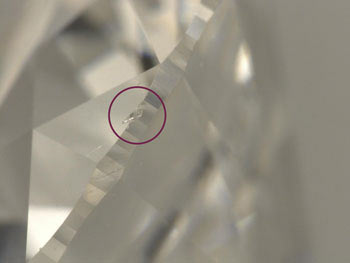
Essentially a hole in the diamond's surface, cavities can be found in a range of sizes and locations across the stone. Depending on its placement, a cavity could affect the overall durability of the stone. Those on the table are likely to be most visible when set in jewelry, compromising the diamond's value and quality.
Chip
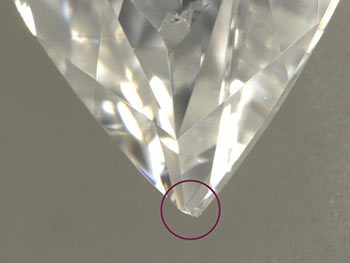
Crystals of other minerals can be included within the larger structure of a diamond. While often a crystal will be a smaller diamond within the diamond, they can also be red garnets, green emeralds, etc. Dark crystals of carbon can also be common. Crystals are found in a variety of sizes, colors and locations. If they are colorful and visible, they may affect the clarity and value of the diamond.
Feathering

Feathering is a fissure within a diamond that was likely created billions of years ago, when the diamond was first forming. The location and size of a feather can affect the clarity grade of its diamond. If located towards the edges, prongs can easily hide a feather. They are only considered a durability issue if found close to the girdle, or as an opening on the surface of the stone.
Knot
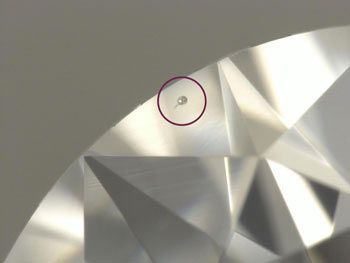
A knot is a diamond crystal inclusion that breaks to the surface of the finished diamond. Under intense magnification, it should be clear where the difference is between the inclusion and the larger stone. During polishing, drag lines can be created as the polishing wheel travels across the inclusion. The knot may be raised above the rest of its facet: depending on its size, you may be able to feel it as you run your finger over the diamond.
Indented Natural

Technically a blemish - as it appears on the outside of the diamond's structure - a natural is an unpolished part of the diamond. Originally part of the rough diamond’s ‘skin,’ these are usually found on or around the girdle. If they travel to the crown or pavilion, they will be considered Indented Naturals. While included in a clarity plot, they do not affect the overall quality or durability of a diamond. Unlike other blemishes or inclusions, Naturals have always been there and are mostly appreciated as a reminder of the diamond's organic history.
Needle
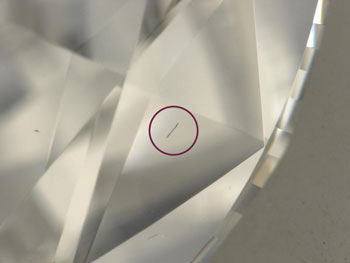
A needle is similar to a feather inclusion - but with only one elongated, very narrow line. They do not typically affect the light return from the diamond, and can be either white or transparent. Some needles can be much longer and therefore more visible than others.
Pinpoint Inclusion
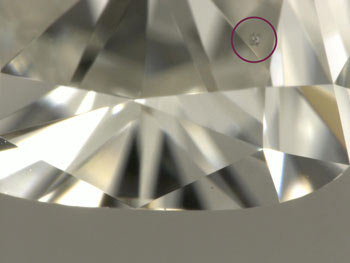
Typically, a pinpoint inclusion is what separates a VVS1 clarity grade from an IF clarity grade. A tiny speck within the diamond, they are usually only detectable under high magnification. They do not affect the overall durability of the diamond.
Twinning Wisp

Twinning wisp (sometimes called inter-growth) is the result of growth defects within the diamond's crystal structure. Different inclusions that have twisted together, they are most commonly found in fancy cuts such as pear-shaped diamonds. With a white striped appearance, these groups of inclusions are generally more detectable than others. They are therefore typically found in diamonds of lower clarity grades, such as SI1.
Internal and external characteristics of the diamond you plan to purchase are shown on an easy-to-read diagram on the diamond grading report. Each inclusion or blemish is indicated with a small symbol in the location of the inclusion.
Diamond Polish
Once a diamond has been cut, it is polished to reveal a smooth finish. Every facet is polished on a wheel to improve the diamond's sparkle. During this process, the polishing wheel can create subtle scratches on the diamond’s surface. Almost every diamond has remnants of polishing marks on its surface. If the scratches are big enough, they can misdirect light traveling through the diamond, decreasing its brilliance.
Once the polishing process is complete, a gemologist assesses these defects and assigns a polish grade, which can be found on the diamond’s grading report. Diamonds with no visible polish defects are given a polish grade of Excellent. Very Good and Good polish grades indicate that the defects are difficult to see, even under 10x magnification. Choose one of these polish grades if you want to ensure superior brilliance.
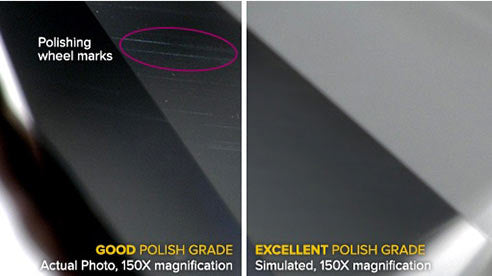
*Ritani does not offer diamonds with Fair or Poor polish grades, making it easier for you to choose a superior diamond.
It’s important to note that diamond polish is graded separately from clarity, and is not considered an inclusion since polish does not penetrate the diamond’s surface.
Buying Tip: Polish has a relatively slight impact on a diamond’s overall appearance, so we do not recommend basing your purchase decision on a diamond’s polish grade alone. However, if you want a truly spectacular diamond, seek those known as Triple Excellent diamonds: Excellent polish, Excellent symmetry and Excellent cut grades.Diamond Fluorescence Approximately 30% of all diamonds naturally emit a glow under ultraviolet light. This is called fluorescence. It is caused by an anomaly in a diamond’s crystal structure, and can range from faint to very strong. Fluorescence is different from a diamond’s color grade, and typically can’t be seen in natural light. Varying levels of fluorescence under UV light. The fluorescence level of your diamond is listed on its diamond grading report. Diamonds with no fluorescence are priced at a premium because the quality is sometimes perceived to be a defect. However, since fluorescence is not usually visible in natural light, it has a negligible effect on the appearance of a diamond; therefore, we do not recommend selecting your diamond based primarily on its fluorescence grade. Generally, diamonds with faint to medium fluorescence are the more cost-effective options; by not paying the premium for a fluorescence-free diamond, you can invest in a higher cut or clarity grade (both of which have much greater impact on the diamond’s appearance). Additionally, a highly fluorescent diamond may actually appear whiter if it also has a color grade of Faint Yellow (K and L) or Near Colorless (I and J) — the blue tones of fluorescence subtly balance out the yellow color tones. This can result in a diamond that looks as if its color grade is higher than it really is. While the majority of diamonds with fluorescence exhibit a blue tone under ultraviolet light, other colors are possible. Rare yellow, orange, green and red fluorescence has been documented. These hues can increase the desirability of fancy colored diamonds if they complement their primary hue. For example, a fancy yellow diamond with yellow fluorescence will have an intensity that appeals to many diamond customers, potentially raising the value of the stone. Diamond Fluorescence Intensity Chart


